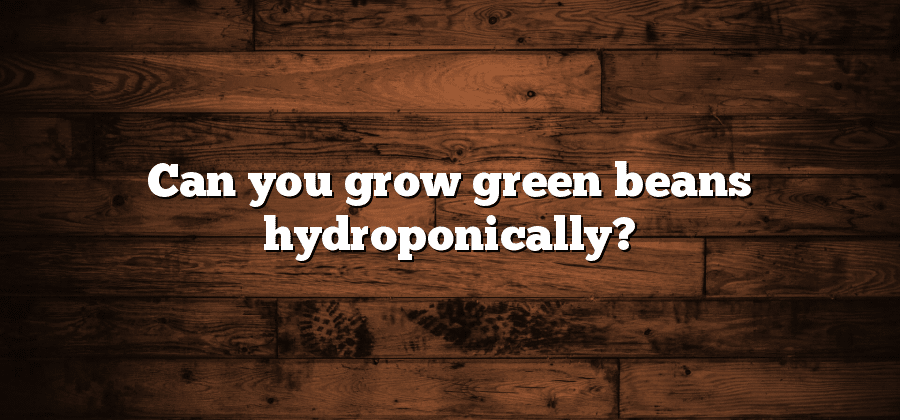Benefits of Hydroponic Green Bean Cultivation
Hydroponic green bean cultivation offers numerous benefits for both commercial growers and home gardeners alike. One of the main advantages of this method is the ability to grow green beans in a controlled environment, regardless of outdoor conditions. This means that growers can produce fresh, high-quality beans all year round, regardless of the season or climate. Additionally, hydroponics allows for precise control over the nutrient solution, ensuring the plants receive the optimal balance of nutrients for healthy growth and maximum productivity.
Another benefit of hydroponic green bean cultivation is the conservation of water and resources. Unlike traditional soil-based growing methods, hydroponics uses a recirculating system which allows for water and nutrients to be reused, significantly reducing water consumption. This not only helps conserve a valuable resource but also minimizes the environmental impact of cultivation. Additionally, the controlled environment in hydroponics systems reduces the need for pesticides and herbicides, promoting a more sustainable and eco-friendly approach to farming.
Ideal Nutrient Solution for Green Beans
The nutrient solution used in hydroponic systems plays a crucial role in the growth and development of green beans. The ideal nutrient solution for green beans should contain a balanced combination of essential macro and micronutrients. These nutrients include nitrogen, potassium, phosphorus, calcium, magnesium, and various trace elements.
It is important to ensure that the nutrient levels are properly adjusted throughout the growing process to meet the specific requirements of green beans at different stages of growth. This can be achieved by regularly monitoring the nutrient solution’s pH and electrical conductivity (EC) levels. Maintaining the correct pH range allows for optimal nutrient uptake, while the EC level provides an indication of the nutrient concentration in the solution. By carefully managing these factors, growers can promote vigorous growth and high yields in their hydroponic green bean cultivation.
Choosing the Right Hydroponic System
When it comes to choosing the right hydroponic system for green bean cultivation, there are a few factors to consider. One of the first things to think about is the available space you have for setting up the system. Depending on whether you have limited space or a larger area, you can opt for vertical hydroponics or a traditional horizontal system. Vertical systems are great for maximizing space as they allow you to grow plants in stacked layers. On the other hand, horizontal systems provide more room for the plants to spread out and grow.
Another important aspect to consider is the type of hydroponic system that best suits your needs. There are various types available, including nutrient film technique (NFT), deep water culture (DWC), and ebb and flow systems. NFT systems are known for their simplicity and efficiency, as they constantly provide a thin film of nutrient-rich water to the plants’ roots. DWC systems, on the other hand, involve suspending the plants’ roots in a nutrient-rich water solution, allowing for optimal nutrient uptake. Lastly, ebb and flow systems work by periodically flooding the growing medium with the nutrient solution, which is then drained away, providing a balance of oxygen and nutrients to the plants.
Therefore, it’s crucial to consider factors such as available space and the type of hydroponic system that will best suit your needs before settling on the right system for cultivating green beans. By carefully considering these aspects, you can ensure that your hydroponic system provides the ideal environment for the healthy growth and abundant harvest of your green bean plants.
Germinating Green Bean Seeds Hydroponically
In the world of hydroponic gardening, germinating green bean seeds is a crucial step towards a successful cultivation. This process allows for the controlled propagation of seeds without the need for soil. By providing the seeds with the ideal environment and nutrient solution, you can ensure that they quickly and effectively sprout into healthy seedlings.
When germinating green bean seeds hydroponically, it is important to choose high-quality seeds and create the perfect conditions for their growth. First, soak the seeds in water for a few hours before transferring them to a seed tray or a paper towel. Make sure to maintain a warm and moist environment to facilitate germination. Remember to regularly mist the seeds with water, avoiding excessive humidity that could lead to fungal growth. With careful attention to detail, you can ensure successful germination and set the stage for a thriving hydroponic green bean garden.
Transplanting Seedlings into Hydroponic Systems
Once the green bean seedlings have reached a suitable size for transplanting, it is time to carefully transfer them into the hydroponic system. This process requires precision and attention to detail to ensure the health and success of the plants.
Before transplanting, it is important to prepare the hydroponic system by ensuring that the nutrient solution is ready and at the correct pH level. The pH should be tested and adjusted accordingly, as it plays a crucial role in the availability of nutrients to the plants. Once the system is properly set up, gently remove the seedlings from their original containers, taking care not to damage the delicate roots. Then, carefully place the seedlings into the holes or growing media of the hydroponic system, ensuring that the roots are covered and supported. After transplantation, it is essential to closely monitor the seedlings for any signs of stress or nutrient deficiencies, making adjustments to the nutrient solution as needed. By transplanting the green bean seedlings correctly and providing proper care, growers can look forward to healthy, vibrant plants and a successful harvest.






